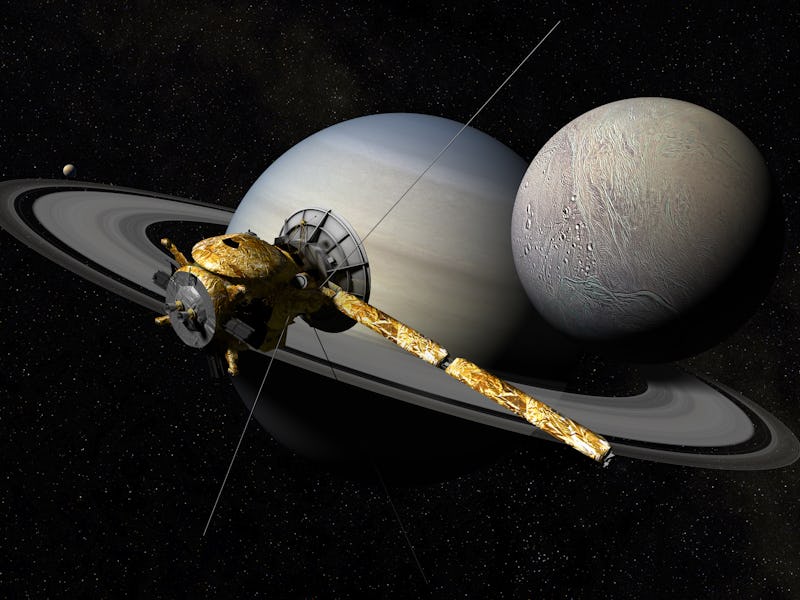In less than 48 hours, Cassini will be less than matter — vaporizing as it plunges headfirst into Saturn’s atmosphere during the wee hours of Friday morning. But while the spacecraft will no longer be working round the clock to unveil the mysteries of Saturn and its moon, this is far from the end of NASA’s investigation of the Saturnian system.
“We left the world informed but still wondering,” Earl Maize, the program manager for Cassini, told attendees at a press conference Wednesday. “We gotta go back, and we know it.”
After 20 years since Cassini was first launched into space, there is no doubt we have much more to investigate — including the chance to find alien life. “We’re here at a very historic time,” said Jim Green, the director of NASA’s Planetary Science Division.
How we decide to proceed is up to us, but one thing is certain: Cassini has a laid a groundwork we couldn’t possibly imagine before.
Here are the five most important things to come out of the mission, and why we’re going to miss Cassini so much.
Cassini observing a total solar eclipse created by Saturn, on September 15, 2006.
1. A gorgeous glimpse of Earth’s backyard
We already knew Saturn was beautiful, but Cassini managed to turn even the most cursory space enthusiasts into Saturnian acolytes. The spacecraft managed to collect half a million images of the system over its 13 year tour, and the result has been a view the planet’s nine-month hexagonal storm system at the pole, a Saturnian eclipse, a surreal look at the planet’s rings, and so much more.
And let’s not forget perhaps the most Cassini image ever captured: a shot of Earth in the distance, dwarfed by the immense glow of Saturn’s rings.
Enceladus, taken by Cassini on February 15 2016.
2. Geyers on Enceladus
“What we thought was an icy ball,” said Green, “…when we observed the southern hemisphere and saw geysers of water, it amazed us, and began changing the way we view the habitability, or potential habitability, of moons in the outer solar system.”
Indeed, there is a lot of hope that Enceladus’s geysers are just a prelude to finding constituent ingredients to life on the moon — or perhaps stumbling on signs of life itself.
Linda Spilker, project scientist for the Cassini mission, thinks that if astronomers had a better sense Enceladus might possess geysers, the spacecraft would have been fitted with more mass spectrometers to observe any presence of amino acids or organic molecules in the vapor plumes spewing off the surface — “to look for life.” Combined with Titan, Spilker credits Enceladus as having “opened up our paradigm for where you would look for life.”
Speaking of Titan…
Titan, as observed by Cassini on May 9, 2017.
3. Titan could be habitable to life
A moon twice the size of atmosphere, with twice the atmospheric pressure of Earth, is what Green calls “a truly magnificent body.” Titan is, “the only other body in the solar system with liquid on its surface,” said Green, referring to the liquid methane ocean which could be a breeding ground for life in its own right. “Perhaps with life not quite as we know it,” concedes Green, but that itself is part of the allure to go back and explore it in greater detail.
The myriad of flybys of Saturn, made possible through gravity assists.
4. Gravity assists are a game-changer for deep space exploration missions
One of the most novel things about the Cassini mission was the way in NASA used gravity assists to help move the spacecraft around the Saturnian system faster, and without too much fuel expense. The Cassini team found Titan to be a brilliant tool with which to make gravity assists work wonders, “to provide new views and observe in beautifully different ways” the planet and its moons.
A flyby of Titan on Monday is actually what put the spacecraft on its trajectory towards Saturn to “seal Cassini’s fate,” said Maize. He and his team call it “the kiss goodbye from Titan.”
Gravity assists greatly aided the Cassini mission, and the extent to which they were utilized for this mission was unprecedented. The agency plans to use what they’ve learned as they move forward with the Clipper mission heading towards Jupiter and its moon, Europa, as well as future missions exploring other parts the solar system. “Cassini has enabled us to make those future missions possible,” said Green.
An animation of Cassini as it plunges into Saturn on Friday.
5. A nearly perfect mission to the end
But perhaps most splendid of all is the fact that Cassini was one of the most successful missions NASA has ever pulled off. After 4.9 billion miles logged, and 162 targeted flybys of Saturn, Maize says Cassini has “just been almost flawless.” When asked what he might have changed if NASA built and launched Cassini all over again, Maize put bluntly, “I wouldn’t have touched a damn thing…this spacecraft — I couldn’t have asked for anything more.”
Moving forward, Cassini will be thought of as a gold standard of unmanned exploration of the solar system and its worlds.
